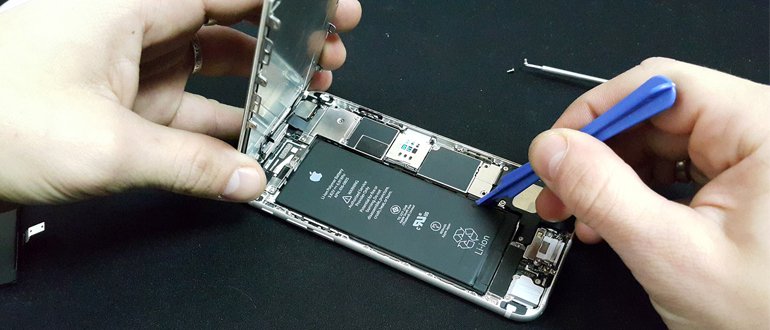Not so long ago, engineers came up with a tricky joke: making smartphones whole. It consists in the fact that it is impossible to remove the back cover with improvised means. Such smartphones cannot be disassembled without specialized equipment, since the front is glued to the back. And access to the battery as it was before is not.
This technology first appeared on Apple's smartphones and was later copied successfully by most other manufacturers. There are pros and cons to creating one-piece smartphones. This will be discussed in this article.
Content
Why did smartphones with a non-removable battery appear
Since the advent of smartphones, manufacturers have clearly understood which devices the end consumer needs. They should be large, comfortable and thin. From that moment, the race of companies began. Everyone tried to make the smartphone more delicate by applying certain measures.
Over time, devices began to appear without the ability to easily get to the battery. The battery was no longer available to the user, it was hidden by a non-removable back cover. To disassemble the smartphone had to heat the screen and peel it from the glue.
Benefits of Built-in Batteries
The main advantage of built-in batteries is their compactness. Since the battery cannot be removed just like that, it can not be protected separately from other elements of the system. That is, the manufacturer removed the additional protective film of the battery and other caps for the cover. This allowed us to make the battery bigger and the case smaller.
The second indisputable advantage was the moisture and dust protection. Cases without the ability to remove the cover are also called solid. They are made of one piece of material and do not have any gaps and holes around the perimeter. Due to this, protection against water, dust and other external factors is significantly increased.
Yes, smartphones still do not have full protection, since the charging connector, speakers, microphones and other elements are still subject to damage. But in general, there are fewer places where water and dust can get.
The less excess elements - the more reliable the design. A principle like no other describes the concept of such a design. With a non-built-in battery, you don’t need to think about latches, protections or other things in production. You can place everything in the case as conveniently as possible and not worry about the inexperienced buyer opening the lid and breaking something.
In addition to protection, such cases stand out for their best ergonomics. Manufacturers do not care about the mechanism of opening and closing, so they insert elements back to back. From this in the smartphone there are no backlashes, creaks and other unpleasant sound and mechanical defects.
Additionally, it is worth pointing out that this method reduces the risk of installing a poor-quality battery by the user. Some loved to constantly change batteries in smartphones. To save money, many bought low-quality batteries and spoiled gadgets from this.
With a solid housing, the owner does not have access to the battery, so the risk of installing a damaged battery is less. In other words, the manufacturer knows better which battery to install in his smartphone and it is better for an ordinary person not to go there.
With a fixed cover, you can use more premium case materials such as metal, glass, ceramics and so on. Removable options prefer plastic because of its flexibility.
Disadvantages of non-removable batteries
Obviously, this design has its drawbacks. One of the main disadvantages was that now it makes no sense to buy additional batteries and charge them separately, and then change them in the device. Since there is no easy access to the battery, it makes no sense to buy several batteries. You will have to regularly charge the gadget itself or use the banks.
An equally significant minus was the procedure for replacing the battery. All energy-saving devices have such a bad property - over time, the maximum charge level drops. From this, the battery keeps working capacity much less, losses can be up to 30%.
This situation requires immediate battery replacement. And to fix it, you have to go to the service center. At home, it is difficult to disassemble the device, but it is easy to damage the main communications of the gadget. Fortunately, the need for this appears only after a few years of active use.
The last disadvantage is the price. The production of all-metal cases is more expensive. Accordingly, smartphones-bars are more expensive. But over time, technology becomes cheaper, and now even budget models are sold with a built-in battery.
Also, a lot of money will fly into replacing a non-removable battery. Although the procedure often does not need to be done, it can bring a lot of trouble. The smartphone will have to be handed over to the masters and wait until they do everything, so the replacement price is unreasonably expensive.
Can I remove the built-in battery
Yes. But this is done through the display. It must be heated, and then with special suction cups and a card to tear off the body. After you unscrew the screws, remove the cable, get the device stuffing and only then start working with the battery.
The battery itself has not changed much. In all mobile devices, it is rectangular or square, inserted into a special compartment to the contacts. Only in the case of the non-removable option, the batteries have thinner walls and there is no serious protection around them.
Often they are installed directly on the structural materials of the device, without having their own department. Do this to save space and better ergonomics. It does not affect reliability in any way, since everything is perfectly protected by the main body.
Then what is the difference between a built-in and non-removable battery
The only difference is the ability to remove the battery yourself and what kind of protection the battery itself has. In the case of a removable device, each person can get a battery in a few seconds. Because of this, the manufacturer is forced to install additional protection inside the case.
After all, the user can damage something when removed. And with an integral case, this can be done only after a series of procedures, therefore, internal protection can be neglected, making the main emphasis on protecting the case.
Which is better to choose
Now the buyer does not have much choice. Inexpensive phones can still be produced with a removable cover, but more premium products have already completely abandoned this. Therefore, in most cases, you do not have to choose.
However, if there is still a choice, the whole building is a priority. It has more significant advantages than removable options. Such cases are more stylish, thin and light. They do not emit strong creaks, do not crumble when dropped, and have better moisture protection.









